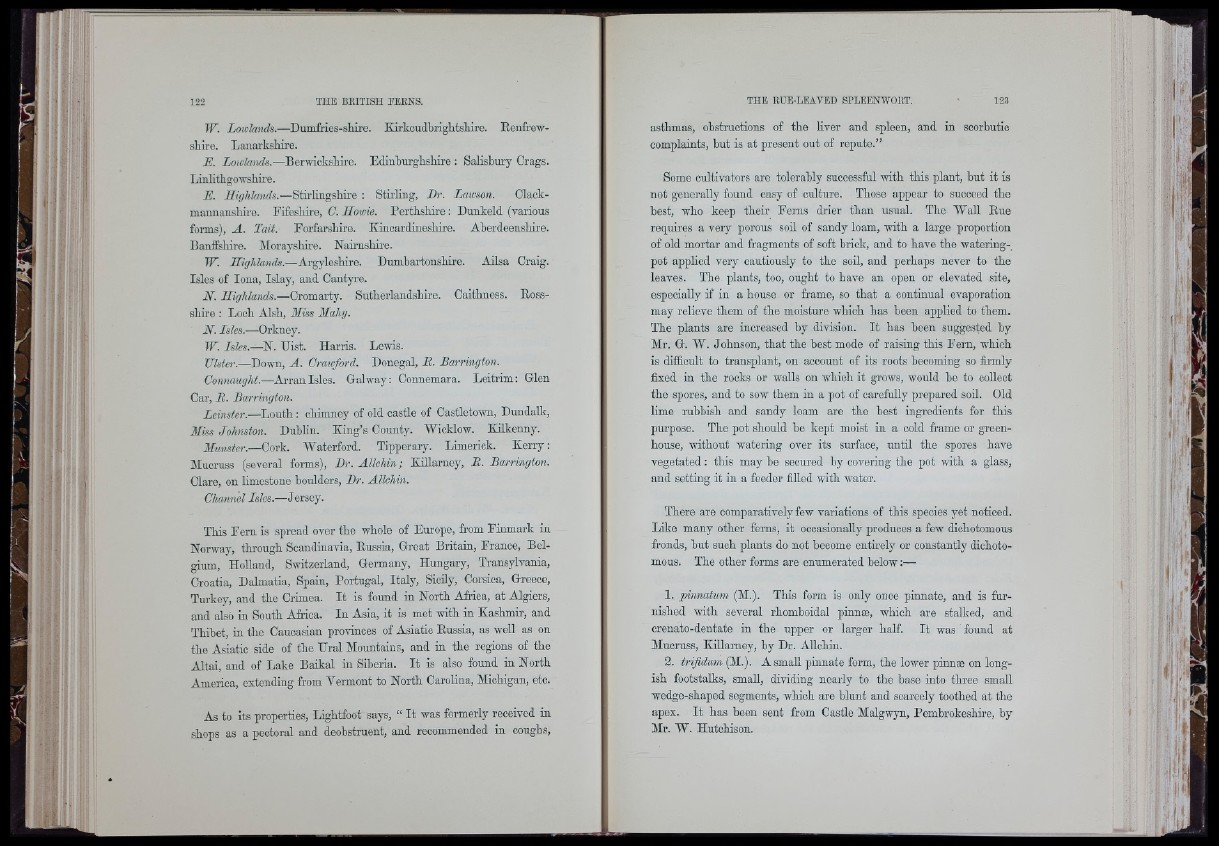
TF. Lowlands.—Dumfries-shire. Kirkcudbrightshire. Eenfrew-
shiro. Lanarkshire.
E. Lowlands.—Berwickshiro. Edinburghshire : Salisbury Crags.
Linlithgowshire.
E. J/ijr/i/fl/ids.—Stirlingshire : Stirling, Br. Lawson. Clackmannanshire.
Fifeshire, C. Howie. Perthshire : Dunkeld (various
forms), A. Tait. Forfarshire. Kincardineshire. Aberdeenshire.
Banffshire. Morayshire. Nairnshire.
W. Highlands.—Argyleshire. Dumbartonshire. Ailsa Craig.
Isles of Iona, Islay, and Cantyre.
N. Highlands.—Cromarty. Sutherlandshire. Caithness. Ross-
shire : Loch Alsh, Miss Mahy.
N. Isles.-—Orkney.
W. Isles.—N. Hist. Harris. Lewis.
Ulster.—Down, A. Craicford. Donegal, R. Barrington.
Connaught.—Arran Isles. Galway: Connemara. Leitrim; Glen
Car, R. Barrington.
Leinster.—Lov&i: chimney of old castle of Castletown, Dundalli:,
Miss Johnston. Dublin. King’s County. Wicklow. Kilkenny.
Munster.—Cork. Waterford. Tipperary. Limerick. Kerry:
Mucruss (several forms), Br. Allchin; KiUarney, R. Barrington.
Clare, on limestone boulders, Br. Allchin.
Channel Isles.—Jersey.
This Lorn is spread over the whole of Europe, from Finmark in
Norway, through Scandinavia, Eussia, Great Britain, France, Belgium,
HoUand, Switzerland, Germany, Hungary, Transylvania,
Croatia, Dalmatia, Spain, Portugal, Italy, SicUy, Corsica, Greece,
Turkey, and the Crimea. It is found in North Africa, at Algiers,
and also in South Africa. In Asia, it is met with in Kashmir, and
Thibet, in the Caucasian provinces of Asiatic Russia, as weU as on
the Asiatic side of the Hral Mountains, and in the regions of the
Altai, and of Lake Baikal in Siberia. It is also found in North
America, extending from Vermont to North Carolina, Michigan, etc.
As to its properties, Lightfoot says, “ It was formerly received in
shops as a pectoral and deobstruent, and recommended in coughs.
asthmas, obstructions of the liver and spleen, and in scorbutic
complaints, hut is at present out of repute.”
Some cultivators are tolerably successful with this plant, but it is
not generally found easy of culture. Those appear to succeed the
best, who keep their Ferns drier than usual. The Wall Rue
requires a very porous soil of sandy loam, with a large proportion
of old mortar and fragments of soft brick, and to have the watering-
pot applied very cautiously to the soil, and perhaps never to the
leaves. The plants, too, ought to have an open or elevated site,
especially if in a house or frame, so that a continual evaporation
may relieve them of the moisture which has been applied to them.
The plants are increased by division. It has been suggested by
Mr. G. W. Johnson, that the best mode of raising this Fern, 'which
is difficult to transplant, on account of its roots becoming so firmly
fixed in the rocks or walls on which it grows, would be to collect
the spores, and to sow them in a pot of carefully prepared soil. Old
lime rubbish and sandy loam are the best ingredients for this
purpose. The pot should be kept moist in a cold frame or greenhouse,
without watering over its surface, until the spores have
vegetated: this may be secured by covering the pot with a glass,
and setting it in a feeder filled with water.
There are comparatively few variations of this species yet noticed.
Like many other ferns, it occasionally produces a few diohotomous
fronds, but such plants do not become entirely or constantly dichotomous.
The other forms are enumerated below
1. pinnatum (M.). This form is only once pinnate, and is furnished
with several rhomhoidal pinnæ, which are stalked, and
crenato-dentate in the upper or larger half. It was found at
Mucruss, KiUarney, by Dr. Allchin.
2. trifldum (M.). A small pinnate form, the lower pinnæ on longish
footstalks, smaU, di'viding nearly to the base into three small
wedge-shaped segments, which are blunt and scarcely toothed at the
apex. It has been sent from Castle Malgwyn, Pembrokeshire, by
Mr. W. Hutchison.
fri
.1J
■ ¡' \
■ m
i
'I I f
i >1
jj
Ml
111